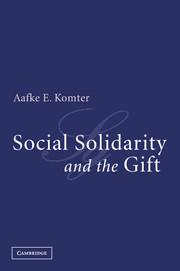2 - Patterns of Giving and Receiving
Published online by Cambridge University Press: 24 November 2009
Summary
Gifts may reflect unfriendliness in at least two final ways. First, the gold watch presented at retirement is normally more representative of a feeling of good riddance than of recognition for achievement; it is indeed a gilded “pink slip.” Lastly, psychoanalytic theories of symbolism suggest that death wishes may be expressed in such gift objects as electric trains, satin blankets, ships, and other vehicles which take “long journeys.” Inasmuch as such theories are valid, the popularity of electric trains as Christmas gifts has enormous implications.
(Barry Schwartz 1996 [1967]: 75)When giving something to another person, our intentions are often not entirely unselfish. We expect that our gift will be reciprocated by a suitable return gift; otherwise we have the feeling that there is something wrong with our relationship to the recipient of our gift. Anthropologists like Malinowski, Mauss, and Lévi-Strauss investigated the impact of moral obligation for the creation of social bonds and a shared culture in non-Western societies and showed that mutual gift giving is an important mechanism behind social cohesion and solidarity. The focus of this chapter is on some fundamental social patterns underlying gift giving in Western societies and on some of the main social-psychological aspects of giving.
From within the discipline of psychology not much empirical research on gift giving has been done, although recently this tendency seems to shift (Otnes and Beltramini 1996). As concerns theory, the main sources of inspiration are still found in the classical anthropological and sociological literature on gift exchange.
- Type
- Chapter
- Information
- Social Solidarity and the Gift , pp. 34 - 55Publisher: Cambridge University PressPrint publication year: 2004



